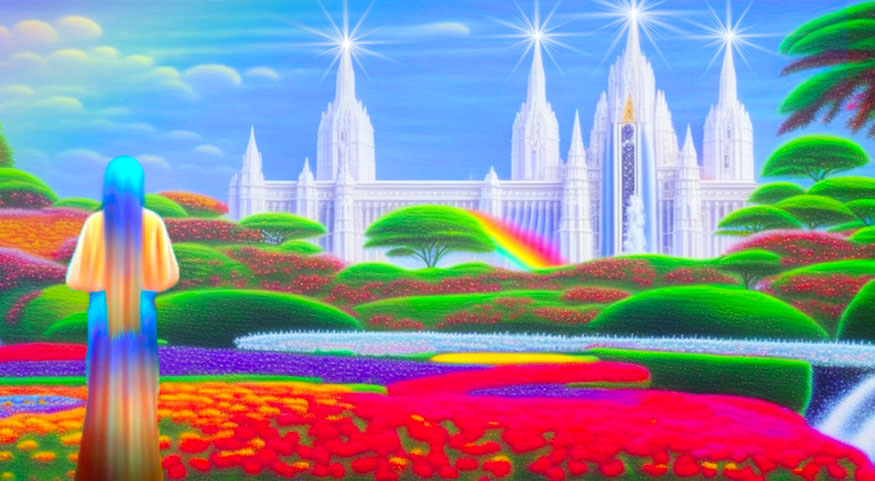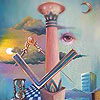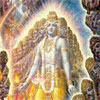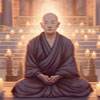The Secret Behind The Great Religions

by Paul M. Vest
From the dawn of civilization the Great Sphinx of Gizeh has crouched in the burning sands of Egypt propounding to the world the formidable mystery of man.
With the cruel claws of a beast of prey but with godlike countenance and mystic eyes fixed in spiritual contemplation, the Sphinx seems to ask of all who gaze upon it, “Man, what art thou? From whence do you come? Whither are you going? Have you crawled up slowly and painfully from the primordial slime or are you an immortal Being whose home is with God?”
All the religions and philosophies of the world have endeavored through the centuries to answer these riddles. Many organized sects have authoritatively claimed a monopoly of truth and denounced all other teachings as false and idolatrous.
But, with all the diversity of beliefs between religious sects, they have been in accord in one great teaching. Every religion has taught that man is immortal; that his spirit comes from a divine world and may eventually return there. This is the great hope and promise that religions offer to man. It is religion’s eternal answer to the defiant cry of the materialist, “There is no God! There are animal instincts and material science. Death is the end!”
Perhaps there is an even greater basic unity behind all of the world’s diverse religions. Perhaps there is a secret, ancient and eternal wisdom running like a shining, golden thread through them all, binding them together, unifying them, irrespective of their superficial, external trappings, rituals, and contradictory dogmas. This thread becomes visible if we view the history of religions from an entirely new standpoint.
The sacred scriptures of all the great religions restate and stress this thought from ancient Mosaic Law, “The letter killeth, but the spirit giveth life.” If we forget the dead “letter” of religions and seek only the “spirit” in each we discover things not commonly taught by the church or the schools.
We discover that most religions have an exterior, popular teaching, and also an interior, esoteric teaching. Especially is this true in the more ancient religions. It is this duality of religious interpretation which causes the majority of people today to believe that religions other than their own are idolatrous, heathenish, ancestor worship, etc., whereas, such merely appears to be the case because only the popular teachings of these other religions are known or studied. Delving deeper into the interior or secret teachings of even the most ancient religions we find that their spiritual teachings were as profound as the most advanced metaphysical teachings of today.
For example, Christian Science, a foremost development in modern religious thought, is actually only a rediscovery and restatement of ancient wisdom. The basic concept of Christian Science, that the real man and the real world are perfect creations and that sin, sickness, death and the evils of the natural world are unreal and illusions of erring mortal mind, can be found in Plato’s philosophy and at an even earlier date in the teachings of the early Brahmans in parts of India.
The great difference in ancient and modern religions is that today the esoteric, inner teachings are open to all who will seek for them, whereas, in antiquity only a comparatively few scholars, priests and scribes were chosen as candidates to receive the secret wisdom, partly because the majority of persons then had neither the time nor the mental nor spiritual capacity to meditate upon and grasp abstract spiritual ideas. Today this still is true of many who must spend nearly every waking hour in earning a livelihood, in raising and caring for families.
Although all orthodox religions teach that “God is spirit and they who worship Him must worship Him in spirit,” many are not quite sure what constitutes spirit or how they are to worship Him in spirit. Consequently in the temples of the ancient religions, as in many modern temples, statues or figures were used to symbolize various aspects of deity.
By contemplating these symbolical figures it was, and is, possible for men to attain greater realization of divinity or perfection. In a Chinese temple today when a devotee prays before and meditates upon the statue of Kwan Yin, The Great Goddess of Mercy, he conceives of the deity as divine love, mercy, compassion and self-sacrifice; as does the Christian offering prayers before a statue of The Blessed Virgin Mary. In the evolution of human consciousness it is necessary for lower concepts of deity to precede higher ones until at last man may truly worship God in spirit only.
Frequently, in the case of many ancient religions, the popular aspect of the religion degenerated to a point where the graven image itself was worshiped. But behind the popular, often profane, outer religion was always the highly spiritual teaching based upon the “secret wisdom” that has been with man from the beginning of time. No matter how widely separated and cut off from each other, religions were we discover, in all, an identical core of spiritual thought.
In the great cult of Quetzalcoatl, Air God of the ancient Aztec civilization of Mexico, we find a popular religion with all the usual gaudy trappings. But the inner religion of Quetzalcoatl, cult of the Sacred Feathered Serpent, is most mystical and in the secret Temples of Initiation the great mysteries of life were revealed to worthy candidates. Ultimately the candidate received proof of his own immortality.
Likewise, in ancient Egypt behind the popular aspect of the religion, were the great Temples of the Mysteries wherein a neophyte similarly experienced the “mystic death” in which his astral body was separated from his physical body and he beheld the latter lying apparently dead in a sarcophagus. Through this mystic resurrection the neophyte forever after knew himself to be an immortal, spiritual being. The Book of the Dead was the sacred book of ancient Egypt and is a highly mystical and metaphysical book for those who can understand its arcane symbolism. “Dead” in the title of the book does not refer to those decreased but to the living – even as Christ later said, “Let the dead bury their dead.” All great spiritual teachers have referred to the “living” as the truly “dead”, buried in the tomb of the body.
The great Aztec and Mayan civilizations had no communication with or knowledge of the civilization of ancient Egypt. How then did it happen that the religious wisdoms of these civilizations are so similar? The Aztecs and Mayans constructed great pyramids resembling those of the Egyptians and all occultists, mystics and Freemasons know that the pyramid is an important symbol of the ancient wisdom and the mystery of man.
In the remote Polynesian Islands of the South Pacific which were completely cut off from all other early civilizations, we find the sacred fire of “true religion” carefully guarded through the centuries by the native priests or Kahunas, “Keepers of the Secret.” A true understanding of the secret Kahuna wisdom reveals it to be as profound as any known metaphysical thought. And as incredible as it may seem, ruins of crude pyramids exist in the Hawaiian Islands.
So in the interior religions of all peoples we discover the profound science, the “secret doctrine”, that is always and forever the same. The ancient prophets were the masters of this wisdom as were the founders of the great religions and spiritual philosophies of the world. Some call them “The Great Initiates.” Included among them are Christ, Moses, Zoroaster, Buddha, Krishna, Mohammed, Hermes, Pythagoras, Plotinus, Confucius, Lao-Tze, Apollonius of Tyana, Plato, Socrates, Aristotle and many others. All taught the same “living” spiritual truths but the vast majority of their followers perceived only the “dead” letter of the teachings. Hence Christ said, “If ye believed (understood) not Moses’ writings, how shall ye believe (understand) my words for he wrote of me.”
The secret wisdom of Ancient Israel as revealed in the mystical Cabbala is the same secret wisdom of the Book of the Dead and of Yoga and of all the many ancient mystery schools throughout the old world. Its truths are the foundation of Masonry, Rosicrucianism, Theosophy, of the great medieval brotherhoods such as the Illuminati, Knights Templars, Druids, Brothers of Light and the Alchemists. Its truths are apparent in every great legend, myth, allegory and parable. The world’s geniuses always have been familiar with the secret wisdom for in the greatest works of art we find its eternal symbols speaking the universal language of the mysteries.
Concerning this science of sciences, an Hermetic treatise states, “Esoteric doctrine is not merely a science, a philosophy, a morality and a religion. It is THE science, THE philosophy, THE morality, and THE religion of which all the rest are nothing but preparations or degeneracies, partial or erroneous expressions, according as they proceed to them or turn aside from them.”
Although it is not possible to express in words the secret wisdom, nevertheless, it is possible to present certain basic precepts which are the foundations of truth in esoteric wisdom of all religions.
Primarily, the secret wisdom discloses that the natural world of mortal man is false, illusory and preponderantly evil. This teaching is disclosed in the wisdom-teachings of all great religions but nowhere, perhaps, is it better expressed than in Plato’s famous allegory of The Cave.
In this allegory the natural world is likened to the gloomy interior of a great cave wherein mortal man is chained in a small boat with others of his fellows. Each man is chained with his back to the entrance of the cave; thus all of them can see only the dismal interior of the cave. They behold the grotesque, fantastic shadows they themselves cast upon the walls of the cave and mistake the shadows for reality even as they believe the deceptive interior of the cave to the rational world. Whereas, the true world lies behind them outside the entrance to the cave but they have no knowledge of that other world or even the faintest conception of its nature.
As Plato’s cave symbolizes the true aspect of the material world, so does Avernus, or Hades, of the ancients. In symbolic language it is the underworld of Greek mythology; the wilderness of Judaism; the hell of Christianity, the land of the dead. Thus according to the secret wisdom the material world, as we ordinarily behold it, is counterfeit, false and even its beauties are but inverted reflections of true reality. The beginning and end of this world and everything within it lie in matter, corruption, evil, decay and death.
But the secret wisdom teaches that beyond the vibrational limits of this false material world is the greater world of true reality. This world is called by many names and has many symbols. Essentially it is the City of God and as such it is timeless, sinless, deathless, incorruptible and eternal.
This world, or state of consciousness, however, is not to be mistaken with various “heaven worlds” in which men dwell between earthly incarnations. The ancient wisdom discloses that these “heaven worlds” are many in number and correspond to a degree with the beliefs of popular religions. In these worlds each person realizes after death the dreams and fulfillments what were denied him in life. Thus the great mystic, Swedenborg, in his clairvoyant visions of “heaven” frequently beheld the domestic life of the “spirits”. His descriptions of these “married angels” portrays them living “as serenely as country parsons and their wives,” although on a glorified scale. Also, he saw the angels playing tennis and indulging in other sports as on earth. In The Secret Doctrine, H.P. Blavatsky explains the intermediate “heaven worlds” as planes of being where each person finds the world of his true desires until he dies the “second death” and reincarnates again in the physical world.
The secret wisdom also divulges that even as God is triune in nature so is man. In simple language, man’s threefold nature is made up of a lower, an intermediate and a higher self.
The lower self is man’s conscious or mortal self and mind and as such it is the false, counterfeit man. The intermediate self functions through man’s subconscious mind and corresponds with the idea of soul. Man’s higher self is the supra-conscious self and is in reality the true, spiritual man created in God’s image and likeness. This true spiritual man is a part of the great unity made up of the higher selves of all mankind which Emerson called the “oversoul”. It is incapable of sin, sickness or death and is the only real and eternal entity. Erring, sinful mortal consciousness can only rarely, if ever, become fleetingly conscious of the true, divine self. When it does, miracles or divine illuminations result as in the case of many great saints and holy men. The great purpose of all religions, schools of the mysteries, spiritual philosophies, spiritual brotherhoods, has been, is, and ever shall be to redeem or “save” the lower, fallen, counterfeit man by aiding him to find union with the higher self, or Christ consciousness.
Different religions strive for this “salvation” in different ways. In the religion of Buddha there are five paths of Yoga (union). A devotee may follow any one of these in his endeavor to attain union with God. These paths are Bhakti-Yoga, union through love and devotion; Hatha Yoga, union through body discipline and training; Raja-Yoga, union through concentration; Karma-Yoga, union through unselfish performance of duty; and Jnana-Yoga, union through attaining perfect understanding of Divine Nature (mind).
The ancient mystery schools and many of the ancient interior religions sought to achieve the neophyte’s salvation through initiations or graduated steps of self-realization. By means of symbols, rites and personal instruction a candidate was enabled to rise ever higher in spiritual thought until at last it was possible for him to transcend mortal consciousness and receive the illumination of his eternal divine self. This was true initiation; and an initiate of The Mysteries forever knew his immortal, or divine self, as a profound reality. Such a man was indeed “born again” into the world of divine principle.
The majority of the various denominations of Christianity and of many other religions strive for the salvation of the fallen man, or lower erroneous consciousness, through imitation or contemplation of the Divine. Thus Christians, in contemplating the perfection of Christ, attain to higher realizations of spirituality. And in constantly striving to imitate the Christ-life, the lower consciousness reaches ever higher toward divinity, or the higher self. Many of the great Catholic saints have attained union with God in this way. They have experienced the beatific vision (vision of the rational world of God). In India this greatest of life’s experiences is called “entering into Samahdi”. In ancient Judaism it is the “vision of the Shekinah Glory”. In the mystery temples of ancient Egypt it was termed “The coming forth by day”. And in many other religions the attainment is spoken of as divine illumination.
Christian Science, on the other hand, has a different approach. Union with Divine Consciousness is sought through denial or negation; that is, the devotee refuses to recognize or acknowledge erring, counterfeit, mortal mind and its corresponding erroneous world of matter. In declaring only the eternal truth of the divine self and acknowledging only the perfect world of divine principle, a Christian Scientist, according to his individual spiritual evolution and perception, may gradually emerge from erroneous mortal mind into the light of spiritual consciousness. Thus eventually through Christian Science the individual may indeed overcome sin, sickness and even death itself, all of which exist only in the lower false consciousness of material man.
Another basic precept of the secret wisdom of all religions is the teaching of reincarnation. Reincarnation has ever been and is today a fundamental esoteric belief of religions. Orthodox Christianity is one of the few religions that does not teach this ancient belief. But at the time of Christ it was an accepted idea and Christ taught this doctrine to the chosen few. There are also other similar references in the Bible and Christ took for granted his disciples’ knowledge of reincarnation. In later years, however, the organized church decided that it was imperative for the material advancement of civilization that the ancient teaching of reincarnation be discontinued and so deleted from the scriptures many of the more direct references to reincarnation. It was believed that the individual would make greater effort in his present life if he had no knowledge of his pre-existences on earth and no certainty of earthly lives to come.
The doctrine of rebirth likens the material world to a school to which a man returns again and again as he slowly and painfully evolves spiritually ever higher toward Divine Consciousness. In each life he is the reaper of that which he has sown in previous lives. This is the ancient law of Karma. Christ restated this inexorable law thus, “Be not deceived (by the apparent victories of evil); God (the divine self) is not mocked (deceived), for whatsoever a man (lower mortal mind) soweth that shall he (lower mortal mind) also reap” (within the world of erroneous mortal consciousness although the actual reaping may come many mortal lives after the sowing). Thus may a man “Sow the wind and reap the whirlwind.” Likewise the dogma of the vicarious atonement is negated by Christ’s words, “I tell thee thou shalt not depart thence (to the city of God) till thou hast paid the last mite” (in the false material world).
In this great school of life there are ever open to man many ways, paths, disciplines, of hastening his union with God. These paths may be found in the interior teachings of any of the great religions, or an individual may become a hierophant in one of the present day schools of the lesser mysteries. Thus may his attainment of liberation be hastened.
If instead, however, he goes the slow spiral path of the vast majority of humanity, which is the way of worldly experience, he likewise will eventually attain union with God although from the standpoint of earthly time, it will take him considerably longer.
Considering the present state of the world and all present day religions, it would appear that Christianity may indeed become the world religion and Christ the Light of the World, as the ancient prophets proclaimed him to be. For, of all the vast multitudes of persons upon this earth, only the most infinitesimal fraction have ever, or probably will ever, voluntarily renounce the world and choose an ascetic way to enlightenment or union with God. For one Gautama Buddha, the prince who renounced his princely heritage and all worldly pleasures for the rags and bowl of a humble beggar and sat lost in meditation until he saw through the illusion and falsity of the material world, there are countless millions who go their way, lost in the pleasures and horrors of materiality.
Thus of absolute necessity the way of mankind becomes the broad highway of the way of worldly experience. This is the Christian path of initiation and ultimately it becomes The Way of Sorrows (Via Dolorosa) as exemplified by the sufferings of Christ and His final agony and crucifixion. For Christ, a master initiate (a true son of God), bore the shame and revilement of the world to show mankind the great way through suffering to resurrection from the tomb of the body to eternal life in the City Foursquare.
For only as the individual man reaps within himself the recompense of error which ultimately manifests in his mortal body and lower consciousness as sin, sickness, sorrow, disease, frustration, pain and physical death, will he in the great extremity of his sufferings turn from the falseness of his “crucified” mortal body and the evils of the material world and cry out to his spiritual self (God) for liberation and light.
In the secret wisdom there have been many symbols representing man. One of these is the Great Sphinx at Gizeh, and another universal symbol of man is the cross. Beyond all of its theological and sometimes profane symbolism lies the esoteric symbolism of the great mystery of the cross. In its deeper meaning the cross symbolizes the higher self (Divine Mind) crucified upon the cross of matter (false mortal mind). Thus the cross becomes the symbol of every living human being. Each one is crucified upon the cross of self (false individualized mortality) until he attains liberation through union with the divine self (God). Thus and only thus is false mortal man truly “redeemed” and becomes in truth The Divine Man made in the image and likeness of God. In the language of mystic Masonry, he has then become The Master Mason, a child of light, who has built the “temple” well and true.
Carved in marble in the ancient temple of Delphi is this cryptic inscription, “Know thyself and thou wilt know the universe and the gods.” Christ stated the same great occult truth thus, “Heaven is within you.”
Source: Fate Magazine, May – 1953
Posted in Other Topics, Spiritualitywith comments disabled.





